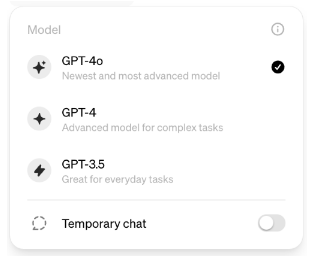How to Use OpenAI's New GPT-4o - Now Available!
GPT-4o (o for omni) is OpenAI's latest artificial intelligence large language model, unveiled during a livestreamed event on Monday. It's multimodal, able to handle both text and image inputs while producing text outputs. In terms of intelligence, it's on par with GPT-4 Turbo, but it's significantly more efficient, faster, and cheaper, as it can generate text twice as fast and is 50% more affordable. Additionally, GPT-4o exhibits superior vision and performance in non-English languages compared to any other models in their lineup.
"This is the first time that we are really making a huge step forward when it comes to the ease of use," OpenAI Chief Technology Officer Mira Murati said during the live. "This interaction becomes much more natural and far, far easier." This release of GPT-4o undoubtedly marks a revolution in human-computer interaction. More importantly, this model will be accessible to everyone, whether you're a paying user or not, allowing you to tap into OpenAI's cutting-edge technology through ChatGPT.
Part 1: How Can I Access ChatGPT-4o?
You can get started with the OpenAI GPT-4o model immediately without any special subscription. GPT-4o is gradually rolling out to ChatGPT Plus and Team users, and will soon be available to free and Enterprise users. Here are instructions on how users of each plan can activate GPT-4o and details on usage restrictions.
For free-tier users:
Users on the free plan will default to using GPT-4o on chatgpt.com. However, there will be limits on the number of messages that can be sent using GPT-4o, which will vary depending on current usage and demand. When unavailable, free users will be back to GPT-3.5.
For paying subscribers:
Users on both the ChatGPT Plus and Team plans can access GPT-4 and GPT-4o on ChatGPT web, with looser usage restrictions compared to free users. These users simply need to select GPT-4o from the dropdown menu at the top of the page to activate the latest ChatGPT model. Plus users can send up to 80 messages every 3 hours on GPT-4o, and up to 40 messages every 3 hours on GPT-4. Meanwhile, ChatGPT Team users have higher message limits on both GPT-4 and GPT-4o compared to ChatGPT Plus. Finally, ChatGPT Enterprise users have unlimited, high-speed access to GPT-4o and GPT-4.

Part 2: GPT-4o's Key Features and Upgrades
GPT-4o isn't exactly an upgrade in the traditional sense. It's more like an enhanced version of GPT-4 with some key improvements:
- Focus on Multimodality: GPT-4o introduces the big leap - it can process text, images, and even audio. This lets it understand information and respond in a more comprehensive way.
- Speed Boost: One major upgrade is speed. GPT-4o is significantly 2X faster than previous models, making real-time interactions smoother.
- Accessibility: OpenAI made a big move by making GPT-4o's core functionalities free for all users. Previously, some features required a paid subscription.
- Memory and Collaboration: GPT-4o can now learn from past conversations and access external information, making it a better collaborator for tasks like research or creative writing.
Overall, GPT-4o isn't just faster, it's a more versatile and user-friendly version of GPT-4 with a focus on natural real-time interaction and collaboration.
Part 3: GPT-4 Turbo vs. GPT-4o
GPT-4o is the clear successor to GPT-4 Turbo. Below is a comparison of several aspects such as Speed, Cost, Performance, Accessibility, Text-based tasks, Multilinguality, Audio, and Vision.
- Generating Speed: GPT-4o runs at double the speed of GPT-4 Turbo due to optimizations in its architecture.
- Cost: GPT-4o is significantly cheaper, costing half as much per token.
- Performance: GPT-4o generally outperforms GPT-4 Turbo's performance on generating more accurate and contextually relevant responses, while excelling in multilingual, audio, and vision capabilities.
- Accessibility: Core functionalities of GPT-4o are free for all users, whereas some features in GPT-4 Turbo might require a paid subscription.
- Text-based tasks: Both models perform well, but GPT-4o shows significant improvement in handling text in non-English languages.
- Multilinguality: GPT-4o is a multimodal model, meaning it can understand and respond to text, images, and audio, whereas GPT-4 Turbo primarily focuses on text. This gives GPT-4o a wider range of applications.
- Audio and Vision: GPT-4o boasts significant advancements in audio tasks like speech recognition and translation, as well as visual understanding.
Final Word
OpenAI's GPT-4o is a major surprise and a significant technological advancement as of May. It's definitely worth giving it a try. No need to pay for a subscription or download. It's a free model, currently available for paid subscribers to experience first in ChatGPT, with availability for free and enterprise users coming soon. Murati said that OpenAI will introduce a ChatGPT desktop application featuring the capabilities of GPT-4o, providing users with an additional platform to engage with the company's technology. Additionally, developers seeking to create their own personalized chatbots can access GPT-4o from OpenAI's GPT store, a functionality that will now be accessible to non-paying users as well.
You Might Also Like
- How to Fix ChatGPT's Internal Server Error: A Comprehensive Guide
- [Solved] ChatGPT Error 1015? Here is How to Fix!
- Why is ChatGPT not Working? 15 Ways You Should Know
- GPT Mentions Unleashed: ChatGPT's Exciting New Breakthrough
- Why Is Chatgpt So Slow? Here's How To Fix ChatGPT So Slow!
- ChatGPT Error: What is 502 Bad Gateway and How to Fix It?

